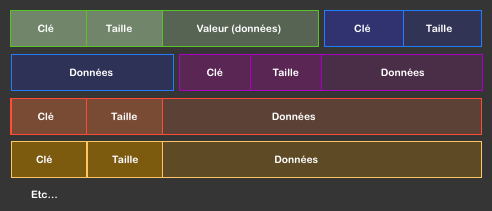
Each brick of an MXF is named a KLV and is represented as follows :

KLV is the contraction of "Key, Length, Value" : it is a data structure defined in following standards :
This structure is quite simple, it is divided into three parts: it starts with a key, then the size of the data and finally with the actual data.
For example, a KLV can be represented in the following schematic form:
| Key | Length | Value |
|---|---|---|
MyKey |
32 |
Lorem ipsum dolor sit amet odio. |
As follows :
MyKey.32 octets long.Lorem ipsum dolor sit amet odio. is the data and is 32 octets long.This example is extremely simplified to aid understanding. We will be come back to its true SMPTE / DCI form later.
Visually, this is what it looks like inside an MXF with several KLV :

As you can see, we always have a sequence of :
Key, Size, Data.
Key, Size, Data.
Key, Size, Data.
...etc...
Each KLV has a variable size depending on several criteria including the size of the data.
To quickly describe each part of the KLV of a specific MXF from a DCP :
Key is a specific SMPTE identifier (known as Universal Label or UL)
060e2b34060e2b34020501010d01020101020400 is an identifier for a Partition Pack - Header which defines an MXF header. Length determines the data size of the Value field.
83000078 :
0x83 indicates that the total size of the Length field is 4 octets (we will see why later)0x00, 0x00, and 0x78. They define the size of the Value field. Converted to decimal, 0x78 gives 120 (octets)Value is the usable data and is made up of :
Here is the raw vieuw of the beginning of an MXF file in hexadecimal form :

We just quickly saw what KLVs are : A key field, a size field and a data field. Nothing more.
If you understand this principle, you already understand half of how an MXF works :)
We will come back to each part in more depth later.
But before that, a quick explanation of the terms Universal Set and Universal Label used in SMPTE documentation, because we will use these terms regularly.
In the SMPTE Cinematic Universe, we love the sweet little names :
The keys / SMPTE identifiers (Key field) are named Universal Label (or UL).
KLV -> Universal Set
Key -> Universal Label
Here's a simplified diagram:

But why these names ?
Because there are also equivalents of the Universal Set and Universal Label but for other KLV stored in the Value part, a kind of baby KLV. These baby KLV are named Local Set and their keys Local Tag.
If we summarize the differents between the two :
| KLV | Baby KLV | |
|---|---|---|
| Name of the KLV | Universal Set | Local Set |
| Name of the key | Universal Label | Local Tag |
Don't ask me why the Local Tag wasn't named "Local Label", probably the creators were probably drunk.
But we will come back for this concept of "Baby KLV" later in the Value chapter.
Now, let's take a look at the Key part.
Except for exceptions, see chapter MXF-KLV-Length ↩
Except for exceptions, see chapter MXF-KLV-Length ↩
